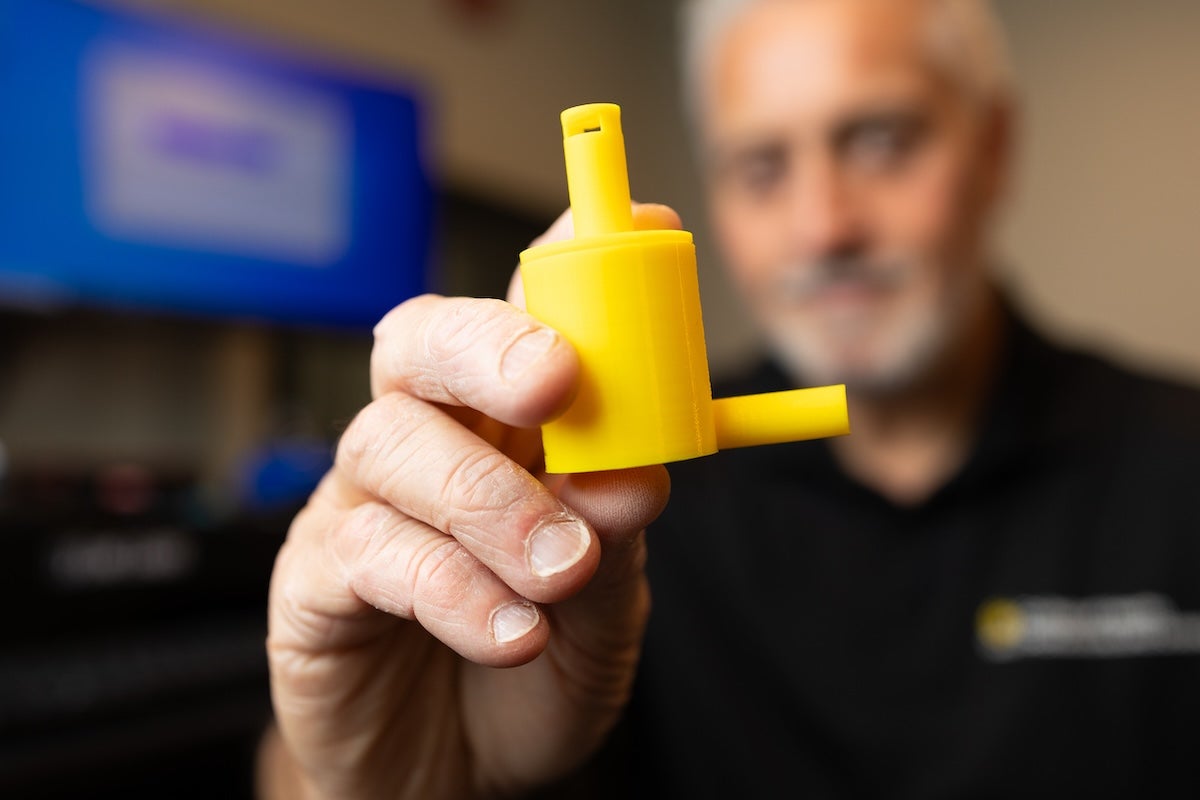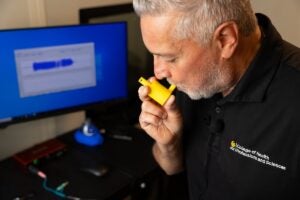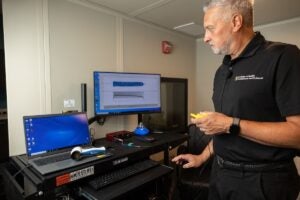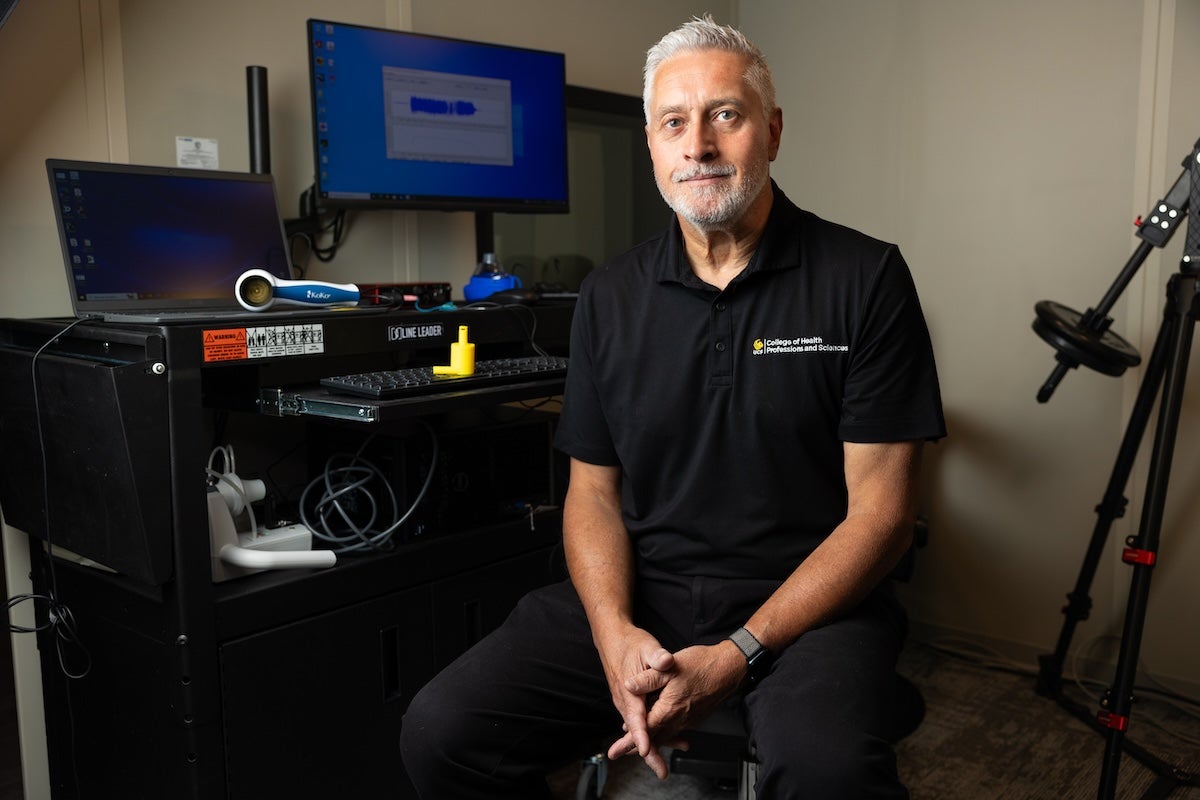Shaheen Awan answers his phone with an immediate apology. “I’m a little hoarse,” he says. “I overused my voice during a two-hour meeting earlier today.”
The irony is obvious. Awan is a speech scientist. Through research, he helps speech pathologists improve clinical services for people with speech disorders. His momentary vocal discomfort creates an opening to discuss — and simplify — his most recent groundbreaking work.
“Being hoarse isn’t necessarily a problem unless it persists for more than two weeks,” Awan says. “When it disrupts daily life beyond an irritation, medical referral and potential speech pathology services come into play. The goal of my research is to help speech pathologists more easily determine the ‘why’ regarding voice disorders.”

With his current research, Awan and his team can literally hear the future of speech pathology. They can see the future, too. In fact, Awan can hold it in the palm of his hand. For more than 30 years, the research professor in UCF’s School of Communication Sciences and Disorders has focused his lifelong interest in acoustics and his expertise in voice evaluation to find the root causes of communication disorders that affect as many as one in ten people in the U.S. One of the unsolved problems in voice-disorder assessments enticed him out of retirement so he could pursue a simple solution, this time with a $3.12 million dollar grant funded by the National Institute on Deafness and Other Communication Disorders and a team of six interdisciplinary researchers from three universities.
Today, Awan and his team believe they have an answer: a whistle. Not a cumbersome costly machine, but a vortex whistle small enough to fit into a shirt pocket. In its final form, it will be biodegradable, disposable, and affordable. It will have no moving parts and doesn’t need to be powered. Awan envisions the whistles being as readily available as a bag of dental-floss picks. Accompanying software that captures and analyzes the vortex whistle tone completes the system.
He also sees them changing lives, soon.
“Our version of the vortex whistle addresses a widely known deficit that speech pathologists deal with in terms of accurately assessing voice-disordered patients,” Awan says.
To uncomplicate the picture, he compares the evaluation of voice to the evaluation of vision. “Imagine if your optometrist said, ‘We really should do one other test to make sure we’re on the right track with your prescription … but we don’t have the equipment because it’s too expensive.’ That’s the scenario what we want to change in speech pathology.”
Voice production, Awan says, combines the physical laryngeal component (the “voice box”) with respiratory airflow. To properly assess and treat patients with voice disorders, four key areas need to be measured:
- Perceptual analysis. “The therapist listens to the patient, describes the voice and categorizes it. This requires training but no additional instrumentation.”
- Visual analysis. “Images of vocal folds, often referred to as ‘vocal cords’, are obtained by a laryngologist or an associated professional under the supervision of a laryngologist).”
- Acoustic analysis. “The acoustic signal is recorded and analyzed for measurements related to a potential voice difference and the severity of the problem. Almost all speech/voice clinicians have access to a computer, microphone and analysis software capable of doing this type of measurement.”
And that leads to number four, the critical link that’s usually missing.
“Aerodynamics,” Awan says. “When you produce voice, the vocal folds vibrate because of air coming up from the lungs. The voice is dependent on the respiratory system’s capacity and ability to generate air flow and pressure. If there’s a deficit in producing or controlling respiratory forces, the voice is often affected. There could be an underlying neurological problem, or a medical issue like asthma or COPD that may require medical treatment or voice therapy. Until now, the respiratory element in speech has been overlooked because there’s been no low-cost, accurate, available method to measure aerodynamics. This vortex whistle, with easy-to-use software, will make it possible in a day-to-day clear-cut fashion.”

Awan talks about how this project came about.
“This all started at a voice disorder conference,” he says. “People were discussing the fact there were no low-cost tools to measure aerodynamics as it relates to voice. In my mind, I knew there must be something out there that could be reimagined.”
Awan, the speech scientist who once thought following his graduate work in the U.S. that he might return to his childhood home in London, Ontario, Canada, to pursue a career in music, used his knowledge in acoustics to consider a few ideas. A flute? A referee’s whistle?
“Neither of them produces a sound specifically related to the amount of air flow going into them,” Awan says. “Then I became aware of the vortex whistle. It has no moving parts. Air enters the cylinder, which forces the air to spiral and exert pressure against the walls of the cylinder before exiting. This creates a signal that has a pitch and frequency that are directly proportional to the amount of air flowing into the whistle. That’s the principle.”
The frequency of the vortex whistle sound wave can then be converted to measurements of airflow and volume.

The vortex whistle’s potential is why Awan took up his friend and colleague, UCF Professor David Eddins, on an offer to unretire, form a team, and work toward applying the science. The NIDCD-funded grant has accelerated the progress. At Purdue, his son, Jordan Awan, leads data analysis while aerodynamics engineer Jun Chen works on modifications of the whistle for specific tasks. At Emory University, Amanda Gillespie conducts studies with voice disordered human subjects. And at UCF, Awan, Eddins and Assistant Professor Victoria McKenna have access to lab space built to spec in the Communication Technologies Research Center in the UCF Innovative Center — sound-treated booths, an anechoic chamber and a reception area for subjects participating in tests. In the same building are a speech and hearing clinic and capabilities for 3D printing and simulation.
“For the vortex whistle to be ready for use, its construction has to be very precise,” Awan says. “It also requires software development to accurately capture and analyze a somewhat difficult soundwave. We’re getting close.”
The Journal of Voice has already published the study from Awan’s team as an award-winning cover story. Since then, various versions of the whistle have been computer-modeled and 3D printed. The modifications are being tested in the first of three large-scale human subject studies. The second study, in 2025, will look at subjects from 5 to 90 years old to see how well the vortex whistle works to document potential changes in measurements of respiratory volume and airflow during voice production across the lifespan. And the final study will utilize the vortex whistle as a treatment-outcome measure before and after medical procedures for vocal-fold paralysis.
From there, the application could be far-reaching.
“My hope with the vortex whistle,” Awan says, “is that we start with speech and voice-disordered patients, and then identify its usefulness in other areas of medicine and associated areas such as exercise science and sports physiology. By making it affordable and accessible, there’s no limit to how many people can ultimately benefit from it.”




